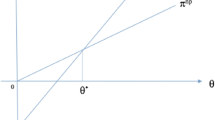Abstract
A patent holder may choose to give up its current leading position through patent licensing in order to increase its incentive to innovate further and thus avoid falling behind its rivals in future R&D races. We show that because of this “catching-up” effect, licensing may occur even when it reduces current industry profits. The overall effect of licensing is to slow down the pace of innovation, as it reduces the licensee's incentive to conduct R&D.
Similar content being viewed by others
References
Arrow, K. J. (1962) ‘Economic Welfare and the Allocation of Resources for Invention’, in NBER conference no. 13, The Rate and Direction of Inventive Activity: Economic and Social Factors. Princeton: Princeton University Press.
d’Apremont, C. and A. Jacquemin (1988) ‘Cooperative and Noncooperative R& in Duopoly with Spillovers’, American Economic Review, 78, 1133-1137.
Gallini, N. T. (1984) ‘Deterrence by Market Sharing: A Strategic Incentive for Licensing’, American Economic Review, 74, 931-941.
Gallini, N. T. and R. A. Winter (1985) ‘Licensing in the Theory of Innovation’, Rand Journal of Economics, 16, 237-252.
Katz, M. L. and C. Shapiro (1985) ‘On the Licensing of Innovations’, Rand Journal of Economics, 16, 504-520.
Katz, M. L. and C. Shapiro (1987) ‘R& Rivalry with Licensing or Imitation’, American Economic Review, 77, 402-420.
Lee, T. and L. L. Wilde (1980) ‘Market Structure and Innovation: A Reformulation’, Quarterly Journal of Economics, 94, 429-436.
Leibenstein, H. (1966) ‘Allocative Efficiency Versus X-efficiency’, American Economic Review, 56, 392-415.
Reinganum, J. F. (1983) ‘Uncertain Innovation and the Persistence of Monopoly’, American Economic Review, 73, 741-748.
Reinganum, J. F. (1985) ‘Innovation and Industry Evolution’, Quarterly Journal of Economics, 100, 81-100.
Scherer, F. M. (1980) IndustrialMarket Structure and Economic Performance.Chicago: RandMcNally.
Shapiro, C. (1985) ‘Patent Licensing and R& Rivalry’, American Economic Review, 75, 25-30.
Tirole, J. (1990) The Theory of Industrial Organization. Cambridge: The MIT Press.
Vaughan, F. L. (1956) The United States Patent System. University of Oklahoma Press.




